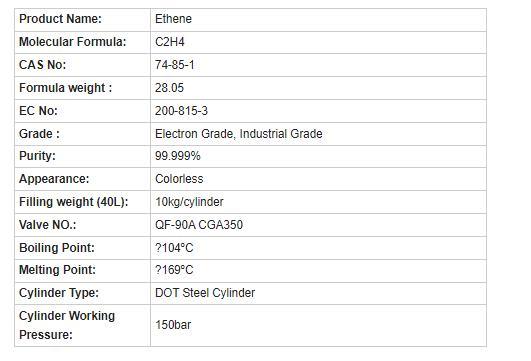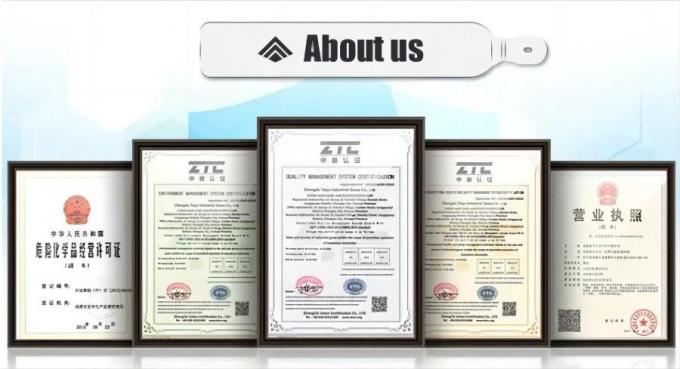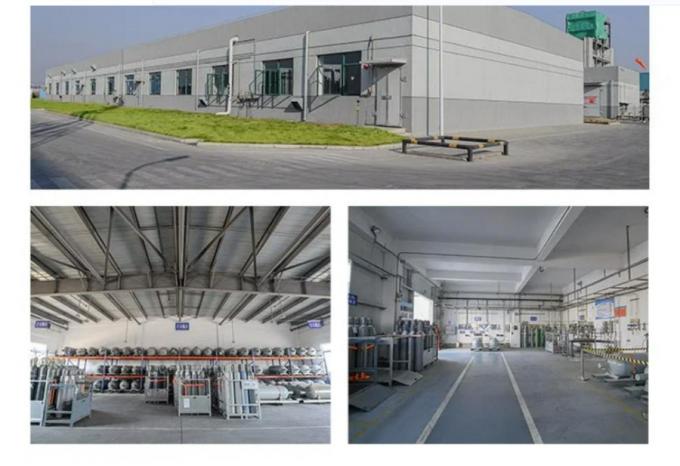


| MOQ: | 1kg |
| Price: | US $2/kg |
| Standard Packaging: | Cylinder/Tank |
| Delivery Period: | 15 days |
| Payment Method: | L/C, T/T |
| Supply Capacity: | 5000kg/month |
Product Description
Ethylene gas (C2H4) is a colorless, flammable gas composed of two carbon atoms bonded to four hydrogen atoms. It is a naturally occurring plant hormone and is also produced industrially for various applications. Ethylene plays a significant role in the growth, development, and ripening of plants. Here are some key points about ethylene gas:
Properties: Ethylene gas has several important properties:
Flammability: Ethylene is a flammable gas and can form explosive mixtures with air. It has a lower flammability limit (LFL) of 2.7% and an upper flammability limit (UFL) of 36%.
Odor: Pure ethylene gas is odorless. However, commercial-grade ethylene may contain impurities that give it a slightly sweet or garlic-like odor.
Density: Ethylene gas is slightly lighter than air, so it tends to rise and disperse in the atmosphere.
Production: Ethylene can be produced through various methods, including:
Natural Production: Ethylene is naturally produced by plants as a hormone to regulate growth and development processes. Fruits, flowers, and other plant parts release ethylene gas during ripening, senescence (aging), and stress responses.
Industrial Production: Ethylene is industrially produced through processes such as steam cracking of hydrocarbon feedstocks, which involves heating hydrocarbons to high temperatures to break molecular bonds and produce a mixture of gases, including ethylene.
Uses: Ethylene gas has several important applications:
Agriculture: Ethylene is used in agriculture to promote fruit ripening, induce flowering in certain plants, and control the growth and senescence of crops.
Plastics and Chemicals: Ethylene is a crucial building block in the petrochemical industry. It is used as a raw material for the production of various plastics, including polyethylene, as well as other chemicals such as ethylene oxide, ethylene glycol, and vinyl chloride.
Controlled Atmosphere Storage: Ethylene is used in controlled atmosphere storage systems to regulate the ripening process and extend the shelf life of fruits, vegetables, and flowers.
Research and Industry: Ethylene gas is used in laboratories and industrial settings for various research purposes, including the testing of materials and as a precursor in chemical synthesis.
Safety Considerations: Ethylene gas is flammable and should be handled with caution. Here are some safety considerations:
Storage and Handling: Ethylene gas should be stored and handled in appropriate containers or cylinders designed for flammable gases. It should be stored in well-ventilated areas, away from ignition sources, heat, and incompatible materials.
Fire Hazards: Ethylene gas can form explosive mixtures with air. Therefore, precautions should be taken to prevent the accumulation of flammable concentrations and to minimize the risk of ignition.
Toxicity: Ethylene gas itself is not highly toxic. However, high concentrations of ethylene gas can displace oxygen in confined spaces, leading to an oxygen-deficient environment. Proper ventilation is essential when working with ethylene gas.
When working with ethylene gas, it is important to follow all safety guidelines and regulations, including proper storage, handling, and ventilation practices, and to have appropriate fire safety measures in place.
Please note that ethylene gas can have different applications and safety considerations depending on the specific industry and context in which it is used.
Basic Info.
| Model No: | C2H4 | Transport Package | Cylinder |
| Specification: | 40L | Trademark | CMC |
| Origin: | Suzhou | HS Code | 2812190091 |
| Production Capacity: | 5000 Tons Per Month |

Detailed Photo
![]()




| MOQ: | 1kg |
| Price: | US $2/kg |
| Standard Packaging: | Cylinder/Tank |
| Delivery Period: | 15 days |
| Payment Method: | L/C, T/T |
| Supply Capacity: | 5000kg/month |
Product Description
Ethylene gas (C2H4) is a colorless, flammable gas composed of two carbon atoms bonded to four hydrogen atoms. It is a naturally occurring plant hormone and is also produced industrially for various applications. Ethylene plays a significant role in the growth, development, and ripening of plants. Here are some key points about ethylene gas:
Properties: Ethylene gas has several important properties:
Flammability: Ethylene is a flammable gas and can form explosive mixtures with air. It has a lower flammability limit (LFL) of 2.7% and an upper flammability limit (UFL) of 36%.
Odor: Pure ethylene gas is odorless. However, commercial-grade ethylene may contain impurities that give it a slightly sweet or garlic-like odor.
Density: Ethylene gas is slightly lighter than air, so it tends to rise and disperse in the atmosphere.
Production: Ethylene can be produced through various methods, including:
Natural Production: Ethylene is naturally produced by plants as a hormone to regulate growth and development processes. Fruits, flowers, and other plant parts release ethylene gas during ripening, senescence (aging), and stress responses.
Industrial Production: Ethylene is industrially produced through processes such as steam cracking of hydrocarbon feedstocks, which involves heating hydrocarbons to high temperatures to break molecular bonds and produce a mixture of gases, including ethylene.
Uses: Ethylene gas has several important applications:
Agriculture: Ethylene is used in agriculture to promote fruit ripening, induce flowering in certain plants, and control the growth and senescence of crops.
Plastics and Chemicals: Ethylene is a crucial building block in the petrochemical industry. It is used as a raw material for the production of various plastics, including polyethylene, as well as other chemicals such as ethylene oxide, ethylene glycol, and vinyl chloride.
Controlled Atmosphere Storage: Ethylene is used in controlled atmosphere storage systems to regulate the ripening process and extend the shelf life of fruits, vegetables, and flowers.
Research and Industry: Ethylene gas is used in laboratories and industrial settings for various research purposes, including the testing of materials and as a precursor in chemical synthesis.
Safety Considerations: Ethylene gas is flammable and should be handled with caution. Here are some safety considerations:
Storage and Handling: Ethylene gas should be stored and handled in appropriate containers or cylinders designed for flammable gases. It should be stored in well-ventilated areas, away from ignition sources, heat, and incompatible materials.
Fire Hazards: Ethylene gas can form explosive mixtures with air. Therefore, precautions should be taken to prevent the accumulation of flammable concentrations and to minimize the risk of ignition.
Toxicity: Ethylene gas itself is not highly toxic. However, high concentrations of ethylene gas can displace oxygen in confined spaces, leading to an oxygen-deficient environment. Proper ventilation is essential when working with ethylene gas.
When working with ethylene gas, it is important to follow all safety guidelines and regulations, including proper storage, handling, and ventilation practices, and to have appropriate fire safety measures in place.
Please note that ethylene gas can have different applications and safety considerations depending on the specific industry and context in which it is used.
Basic Info.
| Model No: | C2H4 | Transport Package | Cylinder |
| Specification: | 40L | Trademark | CMC |
| Origin: | Suzhou | HS Code | 2812190091 |
| Production Capacity: | 5000 Tons Per Month |

Detailed Photo
![]()


